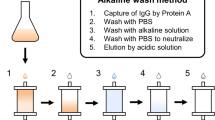Abstract
The correct choice of the elution conditions to break an affinity interaction is important for the successful purification of biomolecules. The optimal elution buffer liberates the bound substance in a minimum volume and maintains the activity of the purified material. The present study demonstrates an enzyme-linked immunosorbent assay (ELISA)-based approach for selection of specific elution conditions for eluting antibodies against a small molecule (atrazine) from pooled sera. Six different elution conditions were tried for the removal of antibodies from the complex. Large-scale purification of anti-atrazine antibodies from the sera was done with a hapten-specific column using an amino-terminal crosslinked agarose gel. Efficacy in terms of total amount of recovery and binding affinities of eluted antibodies from the column were further investigated by ELISA. Results indicate that the ELISA-based elution approach is ideal for the selection of suitable elution buffer that can subsequently be utilized for affinity purification applications.



Similar content being viewed by others
References
Goodrow MH, Harrison RO, Hammock BD (1990) J Agric Food Chem 38:990–996
Marco MP, Gee S, Hammock BD (1995) Trends Anal Chem 14:415–425
Gonyea LM (1977) Clin Chem 23:234–236
Giraudi G, Baggiani C (1996) Analyst 121:939–944
Spinks CA, Wang B, Mills ENC, Michael RAM (1999) Analyst 124:847–850
Jiang F, Kim SH (1991) J Mol Biol 219:79–102
Hudson I, Hay FC (1980) Practical immunology, 2nd edn. Alexander and Thomas, Oxford
Hezmanson GT, Mallia AK, Smith PK (1992) Affinity technique In: Immobilized affinity ligand techniques. Academic, San Diego
Steward MW (1996) Overview: introduction to methods used to study the affinity and kinetics of antibody–antigen reactions. In: Weir M (ed) Handbook of experimental immunology, vol 1. Blackwell, Oxford
Yarmush ML, Antonsen KP, Sundaram S, Yarmush DM (1992) Biotechnol Prog 8:168–178
Yang J, Moyana T, Xiang J (1999) J Chromatogr B 731:299–308
Kummer A, Li-Chan EC (1998) J Immunol Methods 211:125–137
Choi J, Kim C, Ja Choi M (1999) Anal Biochem 274:118–124
Rashid BA, Kwasowski P, Stevenson D (1999) J Pharm Biomed Anal 21:635–639
Raghav GPS, Agrewala JN (1994) J Immunoassay 15:115–128
Victor CWT, Patricia PW (1991) J Immunol Methods 138:291–299
Acknowledgements
The authors are thankful to Dr Chaaya Iyenger for the critical reviewing of the manuscript. We also greatly acknowledge the financial support of the SDC (Switzerland) and DBT (India) under their ISCB research grant.
Author information
Authors and Affiliations
Corresponding author
Rights and permissions
About this article
Cite this article
Singh, K.V., Kaur, J., Raje, M. et al. An ELISA-based approach to optimize elution conditions for obtaining hapten-specific antibodies. Anal Bioanal Chem 377, 220–224 (2003). https://doi.org/10.1007/s00216-003-2066-z
Received:
Revised:
Accepted:
Published:
Issue Date:
DOI: https://doi.org/10.1007/s00216-003-2066-z



